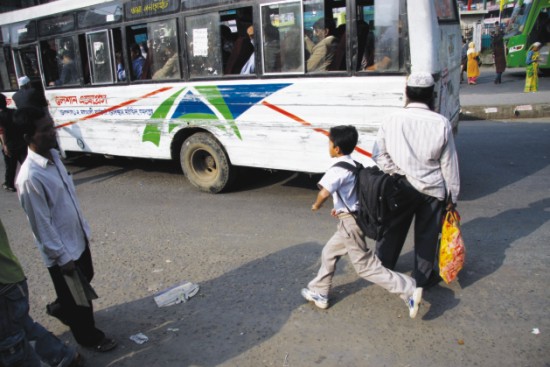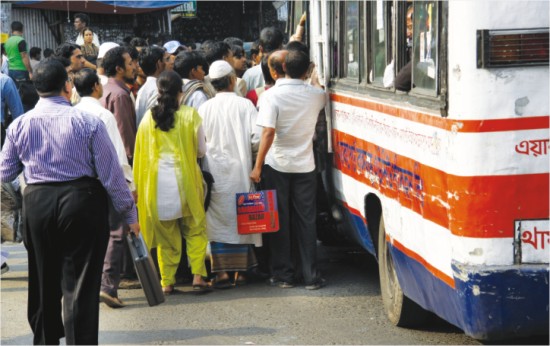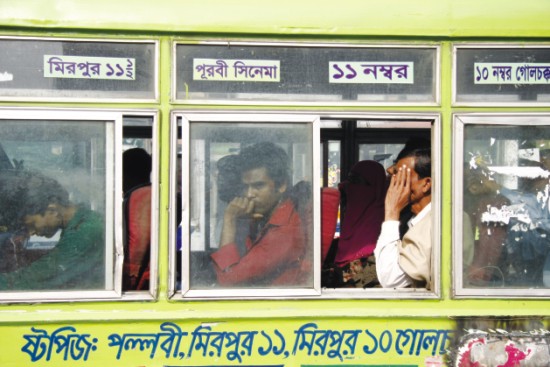
Inside
|
Towards a Sustainable Dhaka Adnan Morshed sketches out what needs to be done
Does Dhaka have a sustainable urban future? The key challenge toward this goal seems to be in finding a comprehensive solution to the city's crippling traffic congestion. These days, the most common of the common grievances in the capital oozes from what is locally known as jaanjot. In fact jaanjot, or Dhaka's traffic quagmire, offers a window into the complex web of interrelated urban dysfunctionalities, political mismanagement, and administrative failures. In a 2008 Forbes list of 25 dirtiest cities of the world Dhaka was a close second behind Baku, Azerbaijan, the former Soviet manufacturing backwater with a life-threatening air pollution level. The report's dismal assessment of Dhaka was right on target reflecting, what lakhs of Dhakaites experience everyday: "Traffic congestion in the capital continues to worsen with vehicles emitting fatal amounts of air pollutants daily, including lead." Traffic congestion, which chokes the natural urban mobility that sustains a city socially and economically, vastly compromises Dhaka's overall livability index and ability to attract foreign investors. Economists and the development community in general often ignore that unhealthy urban environments deter prospective foreign investors. Policy incentives are just not enough. So what is going wrong in Dhaka? Why can't we fix the traffic problem? To think that this is merely a question of urban planning or transportation engineering is to grossly misconceptualise the widespread political, social, and cultural failures that result in the current urban chaos. In fact any sustainable solutions for Dhaka's traffic woes require us to take a 360-degree look at our society. First of all simply going out of our homes has meant facing a plethora of threats: menacing muggers, reckless trucks, and health hazards of all kinds including air, noise, and visual pollution. Any space beyond the private domain -- home, office or the "plot" --is negative. Thus the public places have become the dreaded realm where the middleclass feels besieged by the threat of physical violence, corruption, and extortion. The result of this sorry perception is twofold. First, the middle-class will unfortunately avoid public places and streets that are -- from an urban-planning point of view --considered the vital "organs" of a healthy city. I can foresee people going out of their homes only out of necessity and never for recreation. Second, the city-dwellers grow a deeply unempathetic view of the city. This second effect has become deeply cultural. Spitting in the streets, throwing garbage in exposed drains, complete disregard for the environment beyond one's own "plot," lack of empathy for the city's environmental well-being, and indiscriminate public land-grabbing -- all point toward a complex amalgamation of progress-defying cultural influences that eventually creep into the country's political and policy mind-sets. The government's arbitrary dropping of mega-flyovers or excessive and exclusive reliance on the so-called "master plan" as the solver of all problems often miss the socio-cultural roots of our current urban quandary. But what has it got to do with traffic congestion? If the outdoors is a place to be avoided, the natural inclination for the middleclass is to make bubbles of privacy in the public space. That private bubble is the car, the refuge of the middle-class. But the car is more than that for it provides double dividends: a comforting sense of safety and a membership into the upper middle-class. Approximately 180 officially registered cars now enter the streets of Dhaka each day vying for space already swarming with rickshaws, buses, tempos, trucks, and people. Tragically, social mobility in Dhaka often boils down to how one can create private bubbles in the public space. In the absence of a viable public transportation system, people automatically think of owning a car, and if they can afford one (or two), end up doing so. What is the cumulative effect of this attitude? Take the case of a high-end Dhanmondi school. If there are 300 students, most likely at least 150 students would come to school in private bubbles and create intense city congestion during the beginning and end of school hours. Now imagine how many cars would go off the street if the school could pick up its students from designated collection points by its own private bus manned by private security guards. Mumbai (seventh on the Forbes list), a neighbouring city with a comparable population size and similar outdoor menace, is adopting this policy to address traffic concerns. In the US, going to public school unavoidably conjures up the image of riding that signature yellow school bus! If we are to think of any comprehensive traffic solution for Dhaka, we need to learn how to "de-bubble" our public spaces and streets. But to do that we must understand that there is no alternative to an efficient mass transit system. Take a look at Bogota, Columbia. The former crime-ridden and class-divided city has turned itself around and emerged as an example of sustainable urbanism by introducing an efficient rapid bus transit called TransMilenio. This colour-coded bus system has brought Bogota's various economic classes together, contributing to improved social cohesion and thereby reducing the crime rate. Because a widespread negative view of the outdoors persists in Dhaka, walking in city streets is not appealing. Walking to work is now the romantic relic of a bygone era. Any urban planner would claim that a city's livability is often determined by the quality of its footpaths. But where are our footpaths? They have long been kidnapped by the political mafia and leased out to the local cadre for eventually renting out to the lowest rung of the market chain: the hawkers. Cleaning up the footpath would mean that more people would walk on city streets and rely less on private bubbles. Hawkers could be rehabilitated in city locations designated for the low-end market. Bangkok has done it successfully; people know where to find cheap stuff and go there purposefully. If street-side shop-owners could somehow be convinced that more middleclass pedestrians on the footpath would mean more revenue for them, then they are most likely to turn into unpaid monitors and protectors of the city's vital walking spaces. These are just some suggestions as to how to reduce the traffic pressure on Dhaka's streets. But, to be realistic, a comprehensive traffic solution does not exist solely in the realm of physical planning or transportation engineering; the traffic quagmire that we are in today is a microcosm of our politics, bureaucracy, society, and culture. Therefore, five sets of drivers must come together to work out a comprehensive solution to the traffic problem: the political government, the planning/engineering community, the administrative community, civil society, and the mass media. These drivers need to play their respective roles that would vary in nature and scope but would eventually be coordinated for a long-term solution. The political government must enforce certain top-down policies, some of which must cascade down directly from the Prime Minister's Office with an iron fist: - Decentralisation of urban amenities, work, administration, and education: unburden the city and develop an action plan for polycentric growth; offer tax incentives for garment factories (Dhaka has nearly 20 lakh garment workers) to move out of city limits; decentralise higher education (60 out of total 82 universities of the country are in Dhaka!); the government should lead by example; if some government offices relocate to smaller cities the private sector would follow suit; time has come to think boldly about relocating the Border Guard HQ and the Cantonment to other cities and help spur growth there. Unless there is a holistic decentralisation plan, the urban poor would always wrap around the development epicenter of the country.
- Develop a new National Population Control Strategy (NPCS): Dhaka has the highest per hour birth rate (50+) in the world! Approximately 2,200 people are entering Dhaka, the “city of opportunity,” everyday! No development strategy for Dhaka could be sustained without population control. It is heartening to see that the Prime Minister Sheikh Hasina is now heading the National Population Council. - Develop a National Highway Plan (NHP): bring the whole country under a three-tier (national highway, regional route, and local feeder street) road-communication grid that would distribute the population evenly across the country. - Impose one Car-Free Day (CFD) each week in Dhaka (the city works just fine during hartals, doesn't it?): this would sensitise people about carbon-free environments and help government spearhead a green agenda for the whole country. - Introduce mandatory courses on environmental responsibility from primary schools. Dhaka's jaanjot or traffic clot, is a tangible urban problem, but it is also a product of our collective political, social, and cultural mind. People who whine about getting stuck in the traffic forget that they themselves are contributors to the problem. Flyovers can't rectify the pervasive disrespect for the traffic law and lack of civic consciousness! Many authors have recently made the case that underdevelopment is "a state of mind,” which means that many of our progress-resistant cultural and social habits cause the problems we are in, including the paralysing jaanjot. We want mobility without exercising our share of urban responsibilities. I just push through without paying much attention that my car is blocking the passage of twenty other cars that have the right of way. In his book From the Noble Savage to the Noble Revolutionary, the Venezuelan writer Carlos Rangel argues that Latin America's chaos and poverty are also consequences of its Iberian cultural heritage. Along the same line, the American author Lawrence E. Harrison has studied the underdevelopment of Haiti and has come to the conclusion that superstitious ambivalence toward material progress and fatalistic attitudes toward planning keep Haitians entrenched in poverty. That means no development vision is going to work unless people themselves show the guts to be self-critical and start taking responsibilities for their own destiny. We can pretend to be aghast that in a mega-city like Dhaka there are traffic signals only at 67 road junctions, but what about the corporate honchos who have their drivers park their luxury cars illegally on the super-busy streets in Kawran Bazar and cause the jam that often reaches infernal proportions? The five drivers mentioned above must come together to put in place an urban solution to Dhaka's traffic chaos, which is a political and cultural battle as much as it is a planning problem. When in the late 1990s Bogota's Mayor Enrique Penalossa reclaimed the city streets from the grip of the political and corporate elites and their cars to recreate a city less dependent on private cars and more interested in democratic public plazas, sidewalks, and greenways he was almost impeached by the country's power-wielders. But he survived because his vision of public welfare resonated with the everyday citizen. It was through good planning for a humane city that he inspired the people of Bogota to be better citizens.
There is no doubt about the enormity of Dhaka's urban problems because we experience them everyday. But there should not be any doubt either that Dhaka could be transformed into a livable city, provided there is a good marriage of political goodwill, a sustainable urban vision, and an efficient implementation strategy. Instead of a self-defeating resignation to an ill urban fate we should be proactive and willing to experiment to transform Dhaka into a sustainable city of the future. Planning/Engineering Community: Administrative Community (Rajuk, Dhaka City Corporation, et al): Civil Society: Mass Media: Dr. Adnan Morshed is Assistant Professor, School of Architecture and Planning, The Catholic University of America, Washington, DC.
|


